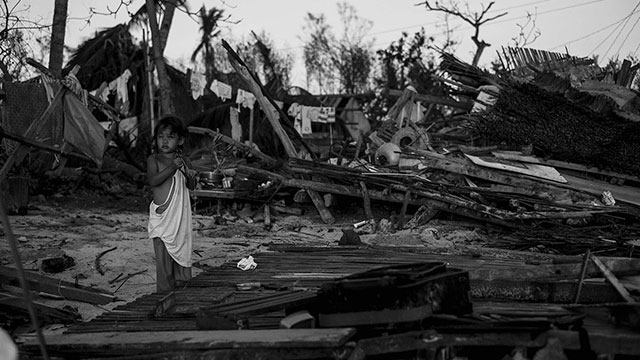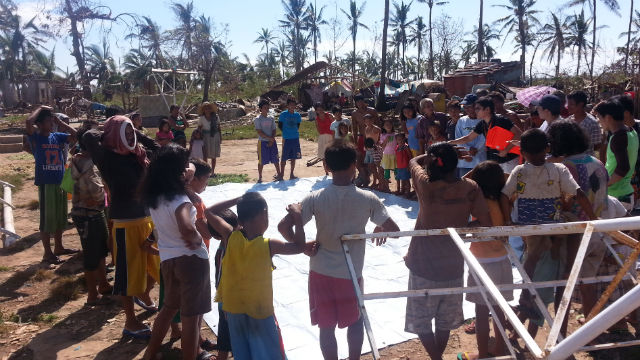SUMMARY
This is AI generated summarization, which may have errors. For context, always refer to the full article.

MANILA, Philippines (UPDATED) – On midnight of Thursday, November 15, Habitat for Humanity sent a team of 29, comprising of Habitat staff and volunteers from Cebu City who intended to distribute 500 emergency shelter kits (ESKs) – which are basically tents – to the isolated islets of Bantayan island.
Upon arrival on Bantayan Island, due to the lack of tugboats and logistical constraints, the team was unable to reach the more isolated areas. They were however able to reach the islet of Barangay Suba, in Sitio Botong, to distribute 113 ESKs.
Home to around 130 families the islet had yet to receive much aid. 100% of the homes on the islet were destroyed and power lines severed, leaving survivors with no access to clean water.
“Donors think that during emergencies the only disaster response is the food response and a lot of people think that the shelter response should come in 3 months later. While in fact even if you feed them for the next 3 months the bottom line is they don’t have a home to go to after that. So habitat is really advocating for shelter response,” says Dabs Liban, Habitat of Humanity’s Resource Development head.
A larger team of 86 Habitat staff and volunteers intended to return to Bantayan island with the logistical support of 3 pump boats to distribute 1,500-2,000 ESKs to islets of Lipayran and Hiltongan.

Logistical nightmare
Since Cebu City is the only place on the island with a serviceable airport it has become a hub for relief operations to station their headquarters. This makes the tasks of obtaining necessary logistical support like access to tug boats, trucks, and the barge that takes passengers from the mainland to Bantayan Island difficult.
When asked if this was the biggest relief operation the organization has done, Liban replied, “Definitely…the logistics support is a nightmare.”
Even if the team leaves Cebu city at midnight to make the 4 am barge, space is not guaranteed. The departure of the barge is also dependent on the rising and lowering of the tide, which can cause operations to stall for as long as another day.
The immediate plan of Habitat, according to Liban, is to distribute as many shelter kits as possible in hard hit Northern Cebu, Guiuan – and when roads are clear and the security situation is controlled – Tacloban. Habitat assessment teams have also reached Capiz and Aklan.
While aid operations still don’t have the logistical capacity to reach other places, Liban believes this should not stop them from first helping the most vulnerable islets that are currently accessible.
“Cebu will play a major role in helping other provinces,” he said.
Hammers on Wheels
The next phase of relief operations is to move on to shelter repair kits that contain hammers, assorted nails, plywood and other materials necessary to rebuild homes that were damaged during the storm.
They are also looking to get the “Hammers on wheels” initiative started. “Hammers on wheels” is a mobile truck filled with tools to repair damaged homes on site by a crew of masons, carpenters, and electricians. So far, Habitat has one of these trucks in Bohol catering to the victims of the recent 7.2-magnitude earthquake.
Liban said more support in terms of volunteers who are skilled carpenters, masons, and electricians, as well as donations from companies or individuals with access to construction trucks and equipment will help speed up the process of setting up a “Hammers on Wheels” initiative in Yolanda-affected areas.
Debris removal
Meanwhile, as international aid organizations like Habitat for Humanity continue to distribute much needed relief efforts to victims, the United Nations Development Programme (UNDP) pledged US$5 million to kick start debris removal in Yolanda-affected areas. This includes clearing roads, and rubble that are adding to the logistical difficulties experienced by aid organizations.
According to Helen Clark, administrator of the UNDP, this is just the beginning. “We urgently need to raise US$ 20 million to achieve our objective of clearing rubble initially for one million people in provinces affected by Typhoon Haiyan,” said Clark in an earlier press statement.
Clark said that as a unit the UN aims to raise a total of $300 million for Haiyan relief response.
The clearing of debris will contribute to improving unsanitary and hazardous conditions for survivors. After debris operations get underway the next phase of relief response is to provide temporary jobs sorely need by over 200,000 victims who have lost their homes, jobs, and businesses in the wake of the disaster.
The UNDP is appealing to donors worldwide to support their efforts through a donation portal on their website. Any contribution goes a long way to help the 13 million people affected, 1.9 million displaced, and thousands who have died from Yolanda’s wrath. – Rappler.com
Add a comment
How does this make you feel?
There are no comments yet. Add your comment to start the conversation.